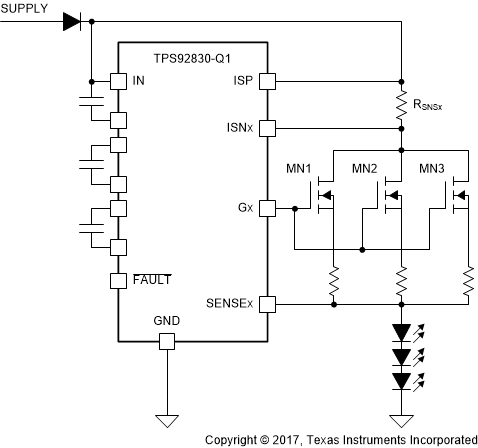ZHCSGY7B October 2017 – January 2018 TPS92830-Q1
PRODUCTION DATA.
- 1 特性
- 2 应用
- 3 说明
- 4 修订历史记录
- 5 说明 (续)
- 6 Pin Configuration and Functions
- 7 Specifications
- 8 Detailed Description
- 9 Application and Implementation
- 10Layout
- 11器件和文档支持
- 12机械、封装和可订购信息
9.2.3 Driving High-Current LEDs With Parallel MOSFETs
Thermal performance is one key consideration in automotive exterior driving, especially for a linear LED driver. Due to large variations of automotive battery voltage, a linear LED driver must accommodate thermal dissipation with a worst-case scenario, which is high ambient temperature and high battery voltage.
LED driver thermal dissipation performance merely depends on the package and PCB thermal dissipation area. However, if the thermal dissipation performance of a single MOSFET is not able to support the required LED string current, multiple MOSFETs in parallel are able to dissipate heat for high-current applications.
When a MOSFET is in the saturation region as a current-control device, its current output strongly depends on its threshold. MOSFET threshold Vth can vary from one device to another. When MOSFETs are in parallel, even a small threshold mismatch could lead to imbalance of current distribution.
With an integrated charge pump, the TPS92830-Q1 device provides sufficient headroom even when the supply voltage is as low as 5 V. Thus adding ballast resistors between the N-channel MOSFET source and the LED string introduces negative feedback for each parallel MOSFET path to balance the current flows.
Table 5. Thermal Measurement of Parallel MOSFETs
| WITHOUT CURRENT BALLAST Resistor | WITH 1-Ω BALLAST RESISTOR | WITH 3-Ω BALLAST RESISTOR | |
|---|---|---|---|
| MOSFET1 Temperature (ºC) | 105.7 | 85.3 | 85.9 |
| MOSFET2 Temperature (ºC) | 76.1 | 82.8 | 84.2 |
| MOSFET3 Temperature (ºC) | 84.8 | 87.6 | 85.3 |
V(IN)= 16 V, I(Total) = 964 mA, TA= 25 ºC.
 Figure 36. Parallel MOSFET Driving
Figure 36. Parallel MOSFET Driving